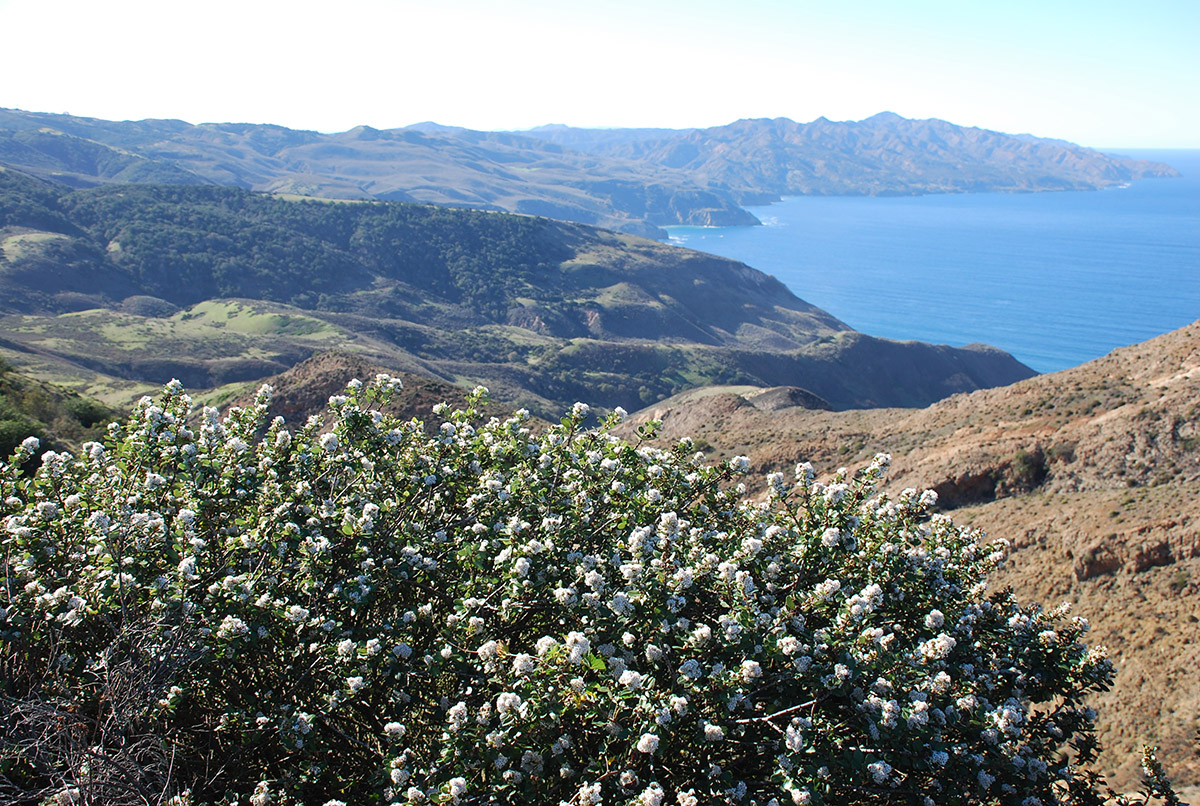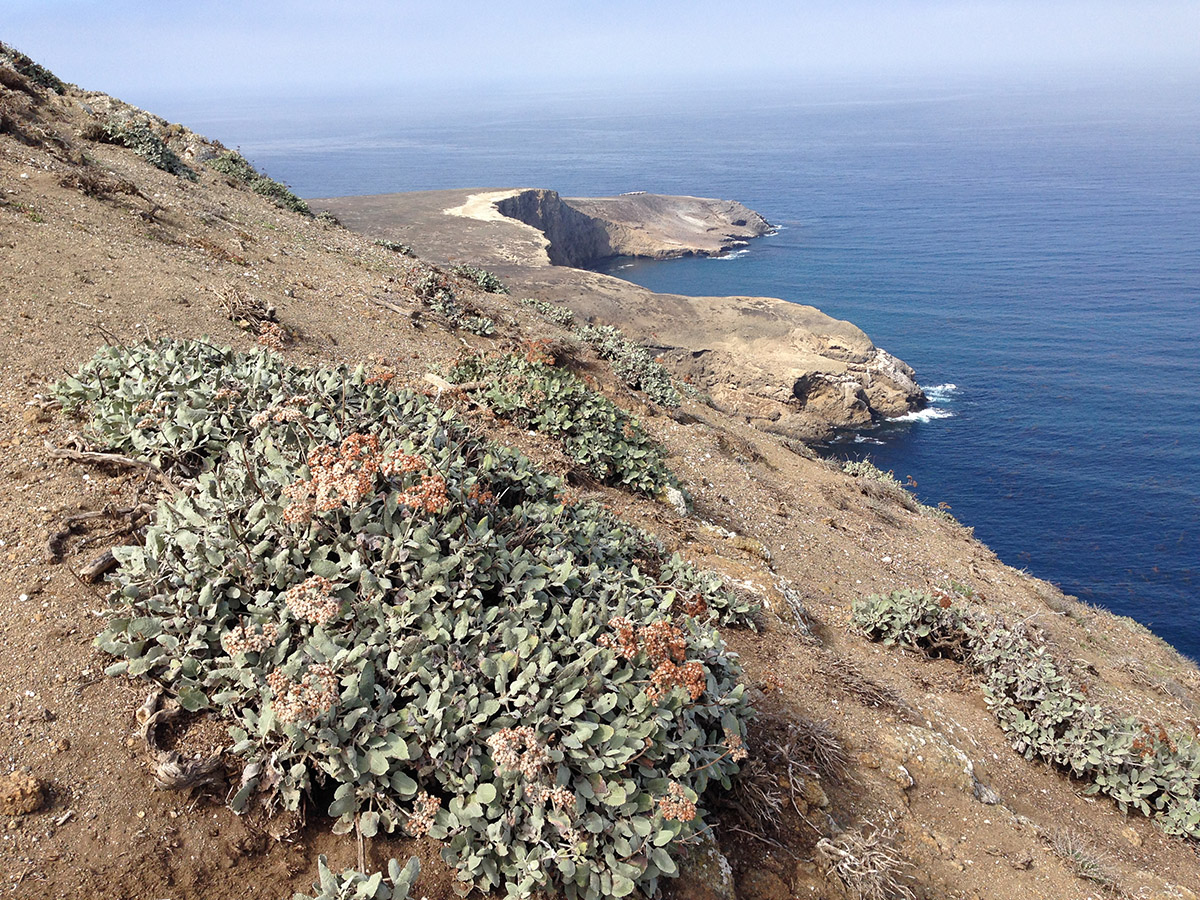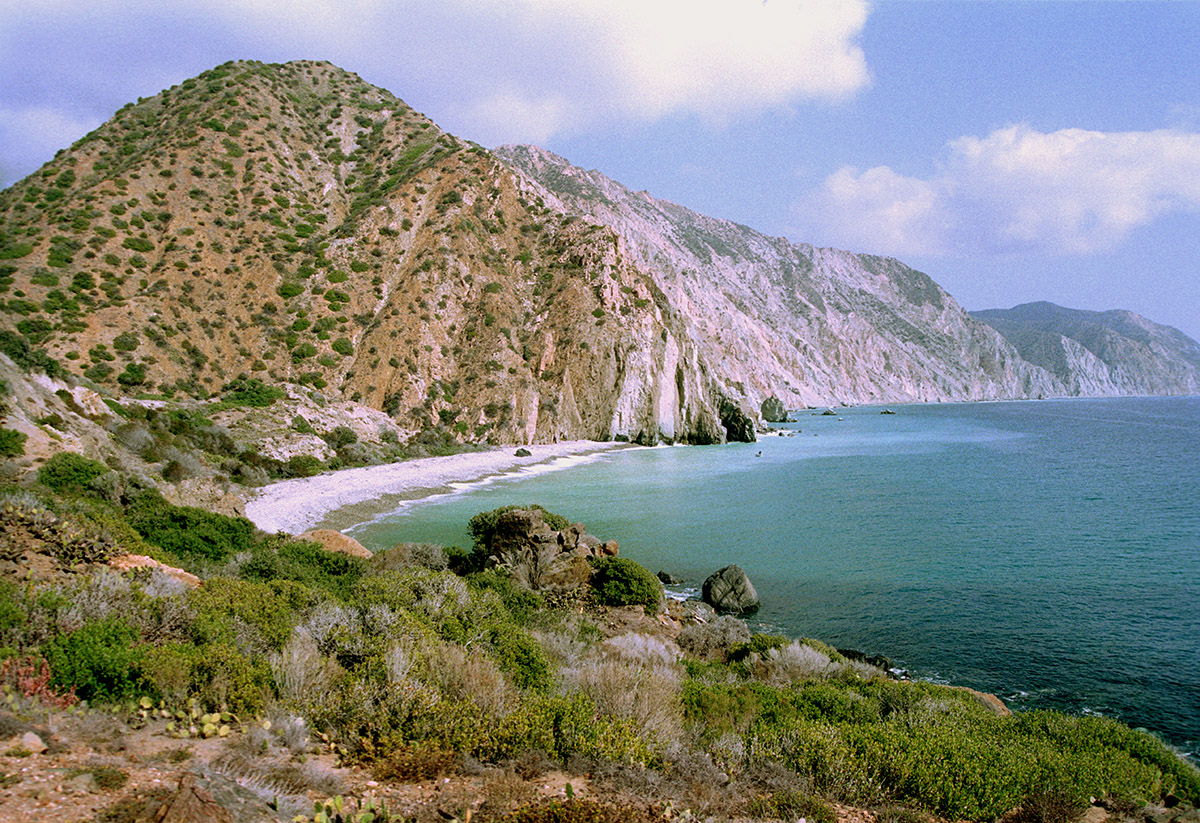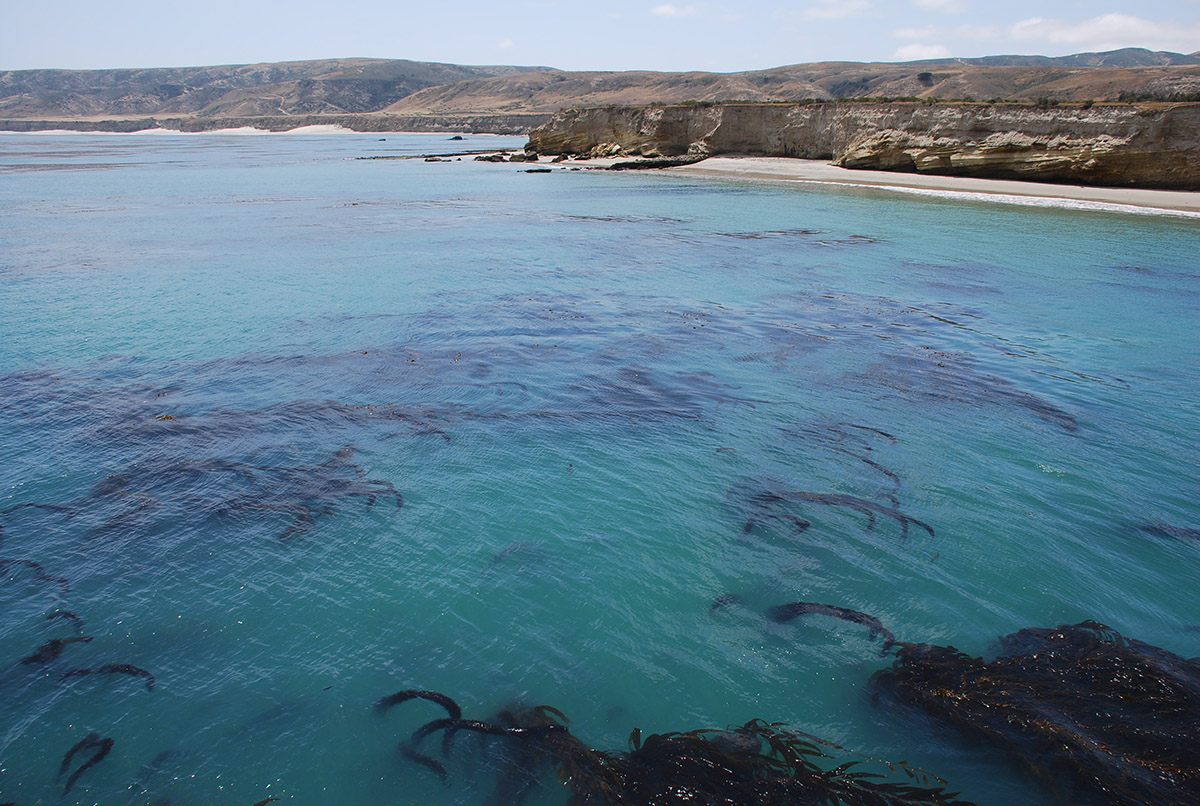The Galápagos of North America

The California Islands
Preserving & Protecting a World Unlike Any Other
Between Point Conception (the elbow of California) and the Vizcaíno Peninsula in Baja California, Mexico, are 16 islands, ranging in size from 1 to 96 square miles (2 to 248 square kilometers). Owned by different institutions — from the U.S. government to nonprofit organizations to the federal government of Mexico — they share several things in common: a similar flora, many species found nowhere else in the world, histories of human uses, invasive species introductions that have devastated their biodiversity, and subsequent conservation and restoration actions. Santa Barbara Botanic Garden has been working together with these institutions to inform conservation since the mid-1900s. Here are some of the resources and tools we’ve helped to develop to improve conservation efforts, making them more effective and efficient.
Impact on the Channel Islands

Santa Barbara Island

Silver Canyon, Santa Catalina Island

Becher’s Bay, Santa Rosa Island

Ceanothus on Santa Cruz Island
The California Islands Biodiversity Information System
In 2014, a contingent of California Islands resource managers and scientists convened to discuss common challenges and opportunities. They agreed that greater information sharing across the archipelago would help to make conservation more efficient and effective. Since then, we have collaborated to create the California Islands Biodiversity Information System (Cal-IBIS). The Cal-IBIS portal in Symbiota aims to document the islands’ biodiversity and includes information on the distribution of plants, animals, and other organisms, including macrofungi and lichens.
This portal compiles information on biological specimens and observations of island species from multiple sources, providing island stakeholders with a single portal that allows them to track and analyze distributions and changes. In future nodes of the information system, which are under development, rare and invasive species’ distributions and management history will be tracked, habitat restoration projects will be documented, and more.
Island Floras
Whether you aim to identify the islands’ plants, figure out where these plants are specifically found, or learn more about each island’s botanical and natural history, it all starts with a “flora” — a list or larger treatment of the plant life of a particular region. Our botanists have been on the scene from the early days, starting with “The Plants of Santa Barbara Island” in 1972 by Ralph Philbrick, Ph.D., which he revised with Steve Junak in 1993. Shortly thereafter, Junak headlined publication of the book-length “A Flora of Santa Cruz Island,” complete with keys, descriptions, and introductory chapters, and illustrations for every plant species by Linda Vorobik, Ph.D. This classic has been a must-have for island flora enthusiasts but has become exceedingly hard to come by.
Never fear, as two more floras are in the works! “A Flora of Santa Catalina Island” is in the prepublication phase, while “A Flora of the California Channel Islands” is in the editing phase.
California Island Symposia
On October 29–30, 1965, the Garden held the first California Islands Symposium on the biology of the California Islands, with 102 registered participants discussing the islands’ geologic history, the nature and origin of their flora and fauna, and the archaeology. This symposium became a tradition recurring every three to five years, with the Santa Barbara Museum of Natural History, Minerals Management Service, Institute for Wildlife Studies, and other organizations all stepping up to help lead this wonderful interdisciplinary gathering of scientists, resource managers, educators, and enthusiasts. The most recent symposium drew over 600 participants!
Here we have gathered the important papers from each symposium for easy access, so anyone interested may investigate the islands’ archaeology, geology, marine ecology, flora, and fauna.
1965: The First California Islands Symposium
Led by Santa Barbara Botanic Garden
1967: Proceedings of the Symposium on the Biology of the California Islands
Edited by R. N. Philbrick
With support from Mr. Harold S. Gladwin, Dr. John B. Loeffer (Office of Naval Research, Pasadena), Louisa Long, Jacqueline P. Broughton, Faith Harder, Peter Feldman, and John Eater
1978: The Second California Islands Symposium
Led by the Santa Barbara Museum of Natural History
1980: The California Islands: Proceedings of a Multidisciplinary Symposium
Edited by Dennis M. Power
With partial financial support from the National Science Foundation, the Atlantic Richfield Foundation, Mrs. Hanscomb, and the Edwin and Evelyn Stanton Fund via Carey Stanton
With editorial and publishing support from Paula Marie Juelke, Sarah Mollett, Evelyn Mulcahy, and the staffs of McAdams Type and Haagen Printing
1987: The Third California Islands Symposium
Led by the Santa Barbara Museum of Natural History
1993: Proceedings of the Third California Islands Symposium
Edited by F. G. Hochberg
With financial support for publication provided by the Southern California Academy of Sciences, Santa Barbara Museum of Natural History, Channel Islands National Marine Sanctuary, Santa Cruz Island Foundation, and Tatman Foundation
Steering Committee: F. G. Hochberg (Santa Barbara Museum of Natural History), Gary E. Davis (Channel Islands National Park), Robert R. Given (Catalina Island), Ralph Philbrick (Santa Barbara Botanic Garden), Carl C. Pillsbury (Channel Islands National Marine Sanctuary), Peter L. Haaker (Southern California Academy of Sciences), Ronald J. Dow (Pacific Missile Test Center), Robert C. Hanse (The Nature Conservancy), Richard E. Pieper (University of Southern California), and Dennis M. Power (Santa Barbara Museum of Natural History)
With editorial and publishing support from Mary Carroll, Jon Keeley, Laurie Marx, T. R. Alpha, Richard Palmer, and Bill McNally of Kimberly Press
1994: The Fourth California Islands Symposium
Led by the Santa Barbara Museum of Natural History
1994: Proceedings of the Fourth California Islands Symposium: Update on the Status of Resources
Edited by W. L. Halvorson and G. J. Maender
With primary financial support from the Department of Defense Legacy Resource Management Program (special recognition to Dick Rugen, Lorri Schwartz, Douglas Ripley, Capt. Laughter, Capt. Boothe, Ron Dow, and Tom Keeney). Additional funding support from the National Marine Sanctuary Program, National Biological Survey, National Park Service, and Santa Barbara Museum of Natural History
Steering Committee: Pete Haaker (California Department of Fish and Game); Steve Williams (California State University, Fullerton); William McFarland (Catalina Marine Science Center); Lt. John Miller (Channel Islands National Marine Sanctuary); Tom Keeney and Steve Schwartz (Naval Air Weapons Station, Point Mugu); Jan Larson (Naval Air Station, San Diego); William Halvorson, Gary Davis, Kathryn McEachern, Peter S. Bennett, Cecil R. Schwalbe, Michael R. Kunzmann, Katherine L. Hiett, Joan M. Ford, Mary N. Greene, Gloria J. Maender, Joel Brumm, Kimberly De Vault, Suzanne Dhruv, Mary Greene, and Jim Russell (National Biological Survey/Channel Islands National Park); Ralph Philbrick and Steve Junak (Santa Barbara Botanic Garden); Eric Hochberg, Dennis Power, and Chuck Woodhouse (Santa Barbara Museum of Natural History); Doug Propst (Santa Catalina Island Conservancy); Marla Daily (Santa Cruz Island Foundation); Rob Klinger (The Nature Conservancy); Jeanne Arnold (University of California, Los Angeles); Jack Engle and Russ Schmidt (Marine Science Institute of University of California, Santa Barbara); and Lyndal Laughrin (Santa Cruz Island Reserve of University of California, Santa Barbara)
1999: The Fifth California Islands Symposium
Led by the Minerals Management Service and Santa Barbara Museum of Natural History
2000: Proceedings of the Fifth California Islands Symposium
Edited by D. R. Browne, K. L. Mitchell, and H. W. Chaney
Published by U.S. Department of the Interior, Minerals Management Service (OCS Study MMS 99-0038)
With financial support from the U.S. Department of the Interior Minerals Management Service, National Park Service, and Santa Barbara Museum of Natural History
Steering Committee (especially those in bold): Ellen Aronson, Marilyn Bishop, Patricia Bowen, David Browne (Chair), Richard Brumer, Jane Carlson, Rodney Cluck, Mary Elaine Dunaway, Catherine Dunkel, Michael Hargrove, James Lima, Bill Mallonee, Craig Ogawa, Mark Pierson, and John Romero (the Minerals Management Service); Kathryn Mitchell and Charles Mitchell (MBC Applied Environmental Service); David Anderson, Robert Breunig, Henry Chaney, Kathy Conti, Eric Hochberg, and John Johnson (the Santa Barbara Museum of Natural History); Gary Davis and Catherin Schwemm (National Park Service); Ben Waltenberger (Channel Islands National Marine Sanctuary/NOAA); Marla Daily and Danielle Greene (Santa Cruz Island Foundation), along with Fred Piltz, Loretta Slusher, Herb Leedy, and Harold Syms
2003: The Sixth California Islands Symposium
Led by the Institute for Wildlife Studies and National Park Service
2005: Proceedings of the Sixth California Islands Symposium
Edited by D. K. Garcelon and C. A. Schwemm
With financial support from The Santa Cruz Island Foundation, The Nature Conservancy, Western National Parks Association, Channel Islands Aviation, Island Packers, the Channel Islands National Marine Sanctuary Foundation, and the Gold Coast Innovation Center
Proceedings funded by the Mediterranean Coast Learning Center of the National Park Service
Edited by Catherin A. Schwemm (National Park Service) and David K. Garcelon (Institute for Wildlife Studies) with support from Greg Schmidt, Christine Steele, Mike Glassow, Tim Coonan, and especially Laura Quattrini
2008: The Seventh California Islands Symposium
Led by the Institute for Wildlife Studies
2009: Proceedings of the Seventh California Islands Symposium
Edited by C. C. Damiani and D. K. Garcelon
With financial support from The Minerals Management Service, the National Oceanic and Atmospheric Administration, Channel Islands National Marine Sanctuary, the Montrose Settlements Restoration Program, the National Park Service California Mediterranean Research Learning Center, the Santa Cruz Island Foundation, the Sea Grant Program of the University of Southern California, Channel Islands National Park, and the Institute for Wildlife Studies
Steering Committee: Shauna Bingham (Channel Islands National Marine Sanctuary), Julie Bursek (National Oceanic and Atmospheric Administration), Tim Coonan (National Park Service), Carlos de la Rosa (Catalina Island Conservancy), Kate Faulkner (National Park Service), David Garcelon (Institute for Wildlife Studies), Michael Glassow (University of California, Santa Barbara), Ann Huston (National Park Service), Lyndal Laughrin (Santa Cruz Island Reserve of University of California, Santa Barbara), Danielle Lipski (Channel Islands National Marine Sanctuary), Yvonne Menard (National Park Service), Fred Piltz (Minerals Management Service), and Catherin Schwemm (National Park Service); additional assistance provided by Emily Dekker-Fiala and the George Wright Society and by John Brooks, John Curwen, Aura de Anda, Bill Faulkner, Ulysses Huerta, Dick Johnson, Cindy Leon, Carol Peterson, Tina Reed, and Rocky Rudolph
With editorial and publishing support from Tim Coonan, Julie Young, Dick Johnson, Rocky Rudolph, Megan Potter, and many anonymous reviewers
2012: The Eighth California Islands Symposium
Catalina Island Conservancy as fiscal agent, lead sponsors Bureau of Ocean and Energy Management and Seaver Institute
2014: Proceedings of the Eighth California Islands Symposium
Edited by M. C. Belk and J. Auger (“Monographs of the Western North American Naturalists”)
With financial support from Bureau of Ocean Energy Management, The Seaver Institute, Catalina Island Conservancy, The Nature Conservancy, National Park Service, the Smithsonian Institution, and the United States Navy
Steering Committee: Shauna Bingham (Channel Islands National Marine Sanctuary), Christie Boser (The Nature Conservancy), Ann Bull (Bureau of Ocean and Energy Management), Tim Coonan (National Park Service), Carlos de la Rosa and Linda Farley (Catalina Island Conservancy), Kate Faulkner (National Park Service), Lynn Gamble (UC Santa Barbara), Ann Huston and Yvonne Menard (National Park Service), Julie King (Catalina Island Conservancy), Annie Little (U.S. Fish and Wildlife Service), Peter Sharpe (Institute for Wildlife Studies), Scott Sillett (Smithsonian Institution), and John Ugoretz (U.S. Navy).
Associate Editors: Brooks B. Britt and C. Riley Nelson (Brigham Young University), Kathryn McEachern and Daniel R. Muhs (U.S. Geological Survey), Sharon R. Melin (National Oceanic and Atmospheric Administration), Scott A. Morrison (The Nature Conservancy), Torben Rick (Smithsonian Institution), and T. Scott Sillett (Smithsonian Conservation Biology Institute)
2016: The Ninth California Islands Symposium
Santa Barbara Botanic Garden as fiscal agent, lead sponsor Bureau of Ocean and Energy Management
2018: Proceedings of the Ninth California Islands Symposium
Edited by M. C. Belk and J. Auger (“Monographs of the Western North American Naturalists”)
With financial support from the Bureau of Ocean Energy Management; Santa Barbara Botanic Garden; The Nature Conservancy; the National Park Service; the U.S. Fish and Wildlife Service; California State University, Channel Islands; Institute for Wildlife Studies; Catalina Island Conservancy; the U.S. Navy; Smithsonian Institution; Channel Islands National Marine Sanctuary; Santa Cruz Island Reserve of University of California, Santa Barbara; the Santa Barbara Zoo; Wildlands Conservation Science; Island Packers; Aquasports; Channel Islands Restoration; Growing Solutions; Ocean Science Trust; and REI
Proceedings funded by the Bureau of Ocean Energy Management
Steering Committee: Julie Bursek (National Oceanic and Atmospheric Administration), Christie Boser (Co-chair; The Nature Conservancy), Ann Bull (Bureau of Ocean and Energy Management), Amy Catalano (Catalina Island Conservancy), Cause Hanna (Santa Rosa Island Research Station of California State University, Channel Islands), Laura Kirn (National Park Service), Denise Knapp, Ph.D., (Co-chair; Santa Barbara Botanic Garden), John Knapp (The Nature Conservancy), Kate Faulkner (retired National Park Service), Annie Little (Co-chair; U.S. Fish and Wildlife Service), Paula Power (retired National Park Service), T. Scott Sillett (Smithsonian Conservation Biology Institute), Peter Sharpe (Institute for Wildlife Studies), and John Ugoretz (U.S. Navy)
With editorial and publishing support from E. Arthur Bettis III (University of Iowa), Michael A. Glassow (University of California, Santa Barbara), David A. Holway (University of California, San Diego), William K. Laurenroth (Yale University), Daniel R. Muhs (U.S. Geological Survey), C. Riley Nelson (Brigham Young University), John M. Randall (The Nature Conservancy), T. Scott Sillett (Smithsonian Conservation Biology Institute), and Morgan Baker (Western North American Naturalist)
Trends & Gaps in Island Floral & Faunal Specimens
The goal of this project was to reveal spatial, temporal, and taxonomic gaps and trends in biological specimens on the California Channel Islands to guide future research and conservation. Our expert team gathered specimens and observation records for the plants, mammals, birds, herpetofauna, bryophytes (mosses, liverworts, and hornworts), lichens, macrofungi, and invertebrates and assessed them for places where information is lacking — either for particular islands or island locations, for periods of time, or for particular taxonomic groups. This study has generated a plethora of insights and recommendations for future work and has resulted in new or updated checklists for the lesser-known groups.
Special Issue on the Flora & Vegetation of the Islands of the Californias
The islands have some fascinating floral stories to tell, including the people who have studied them, the plants which have both been made rare and recovered via human actions, and the habitats that we are working to restore.
In 2017, these stories were compiled in one remarkable special issue of Fremontia (now called Artemisia), the journal of the California Native Plant Society. Note the Garden authors Matt Guilliams, Ph.D.; Steve Junak; Heather Schneider, Ph.D.; and Denise Knapp, Ph.D., throughout these pages.
Artemisia (Fremontia Vol. 45, No. 3)
Introduction to This Special Issue on the Flora and Vegetation of the Islands of the Californias
Remarkable Flora of the California Islands
Early Botanical Personalities of the Channel Islands
Resilience of Unique Island Vegetation
Remarkable Recoveries and Fantastic Discoveries
Restoration and Protection of the Archipelago’s Flora and Habitats: A New Era
The Future of California Islands Conservation in a Changing World
 Donate
Donate